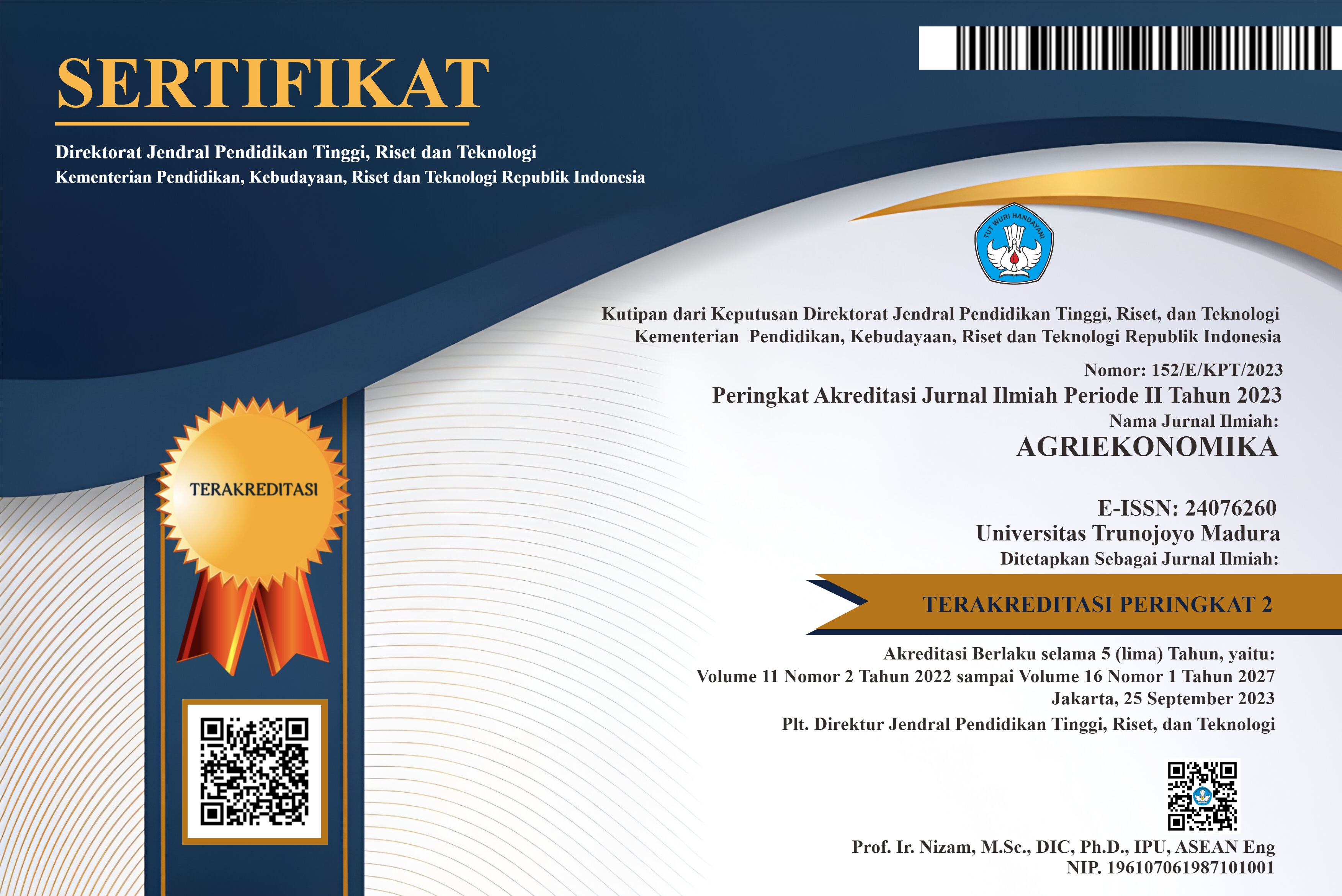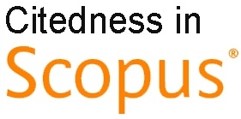Agricultural industry in West Papua Province: An analysis of backward and forward linkages
Abstract
Keywords
Full Text:
PDFReferences
Aldasoro, I., & Angeloni, I. (2015). Input–output-based measures of systemic importance. Quantitative Finance, 15(4), 589–606. https://doi.org/10.1080/14697688.2014.968194
Arifah, L. F., & Sunarjo, D. A. (2021). Analisis Keterkaitan Antar Industri di Sumatera Utara dan Pengaruhnya terhadap Perekonomian Indonesia Tahun 2016 (Analisis IO dan IRIO). Jurnal Ekonomi Dan Statistik Indonesia, 1(3), 213–226. https://doi.org/10.11594/jesi.01.03.08
Axelsson, T., & Palacio, A. (2018). Transforming Indonesia: Structural Change from a Regional Perspective, 1968–2010. In Agricultural Development in the World Periphery (pp. 281–305). Springer. https://doi.org/10.1007/978-3-319-66020-2_11
Bank Indonesia. (2020). Laporan Perekonomian Provinsi Papua Barat November 2020. Bank Indonesia.
Bappenas. (2018). Indonesia Growth Diagnostics: Strategic Priority to Boost Economic Growth. Ministry of National Development Planning/ National Development Planning Agency, Directorate for Macroeconomic Planning and Statistical Analysis. Jakarta.
Booth, A. (2002). The changing role of non-farm activities in agricultural households in Indonesia: Some insights from the agricultural censuses. Bulletin of Indonesian Economic Studies, 38(2), 179–200. https://doi.org/10.1080/000749102320145048
Bordey, F., Moya, P., Beltran, J., & Dawe, D. (2016). Competitiveness of Philippine Rice in Asia. Science City of Muñoz (Philippines): Philippine Rice Research Institute and Manila (Philippines): International Rice Research Institute.
BPS. (2021). Tabel Interregional Input-Output Indonesia Tahun 2016. Direktorat Neraca Produksi, Badan Pusat Statistik.
BPS Papua Barat. (2019). Hasil Survei Pertanian Antar Sensus (Sutas) Provinsi Papua Barat Seri-A2. Badan Pusat Statistik Provinsi Papua Barat. Manokwari.
BPS Papua Barat. (2021). [Seri 2010] Distribusi Persentase PDRB (Persen), 2019-2020. Badan Pusat Statistik Papua Barat. https://papuabarat.bps.go.id/indicator/52/230/1/-seri-2010-distribusi-persentase-pdrb.html
Choiroh, A., Herman Cahyo, D., & Siti, K. (2020). Peranan Subsektor Tanaman Pangan Terhadap Perekonomian Jawa Timur: Pendekatan Input - Output. Jurnal Ekonomi Ekuilibrium, 4(1), 17–26.
Fauzi, A. (2010). Ekonomi sumber Daya Alam dan Lingkungan Teori dan Aplikasi. Penerbit PT Gramedia Pustaka Utama, Jakarta.
Fuglie, K. O. (2004). Productivity growth in Indonesian agriculture, 1961–2000. Bulletin of Indonesian Economic Studies, 40(2), 209–225. https://doi.org/10.1080/0007491042000205286
Fuglie, K. O. (2010). Sources of growth in Indonesian agriculture. Journal of Productivity Analysis, 33(3), 225–240. https://doi.org/10.1007/s11123-009-0150-x
Marks, D., Bierman, W., & van Zanden, J. L. (2020). Occupational structure and structural change in Indonesia, 1880–2000. Australian Economic History Review, 60(1), 27–45. https://doi.org/10.1111/aehr.12191
Marlianti, N., Wahyunadi, I. H., & Harsono, I. (2017). The role of agricultural sector on the economy of West Nusa Tenggara (input-output analysis approach). Jurnal Ekonomi Dan Studi Pembangunan, 9(2), 176–189. https://doi.org/10.17977/um002v9i22017p176
Miller, R. E., & Blair, P. D. (2009). Input-output analysis: foundations and extensions. Cambridge university press.
Nguyen, H. T. (2021). Intersectoral linkages and imports of Vietnam: an input–output approach. International Journal of Economic Policy Studies, 15(1), 205–231. https://doi.org/10.1007/s42495-021-00057-2
Pribadi, D. O., Putra, A. S., & Rustiadi, E. (2015). Determining optimal location of new growth centers based on LGP–IRIO model to reduce regional disparity in Indonesia. The Annals of Regional Science, 54(1), 89–115. https://doi.org/10.1007/s00168-014-0647-8
Rafiqah, W., Darsono, D., & Sutrisno, J. (2017). Analisis Keterkaitan Sektor Pertanian dengan Sektor Lain Pada Perekonomian Provinsi Jawa Tengah. Prosiding Seminar Nasional Fakultas Pertanian UNS, 1(1).
Rondhi, M., Pratiwi, P. A., Handini, V. T., Sunartomo, A. F., & Budiman, S. A. (2018). Agricultural land conversion, land economic value, and sustainable agriculture: A case study in East Java, Indonesia. Land, 7(4), 1–19. https://doi.org/10.3390/land7040148
Rosyida, A. A., & Bhakti, D. (2022). Keterkaitan Antar Lapangan Usaha di Provinsi Kepulauan Riau dan Hub-ungan Ekonomi dengan Provinsi Lain: Analisis IO Dan IRIO 2016. Jurnal Ekonomi Dan Statistik Indonesia, 2(1), 44–58. https://doi.org/10.11594/jesi.02.01.06
Suryani, T. (2013). Analisis peran sektor ekonomi terhadap pertumbuhan ekonomi Kabupaten Pemalang (Analisis tabel input output Kabupaten Pemalang tahun 2010). Economics Development Analysis Journal, 2(1). https://doi.org/10.15294/edaj.v2i1. 1005
Syofya, H., & Rahayu, S. (2018). Peran Sektor Pertanian terhadap Perekonomian Indonesia (Analisis Input-Output). Manajemen Dan Kewirausahaan, 9(3), 91–103. https://doi.org/10.31317/jmk.9.3.91-103.2018
Tapi, T., Tapi, M., & Sopacua, B. N. H. (2021). Langkah Antisipatif Membangun Kemandirian Pangan Lokal Masyarakat di Papua Barat selama Masa Pandemi Covid-19. Prosiding Seminar Nasional Pembangunan Dan Pendidikan Vokasi Pertanian, 2(1), 102–113. https://doi.org/10.47687/snppvp.v2i1.203
Tarigan, R. (2009). Ekonomi Regional: Teori Dan Aplikasi. PT. Bumi Aksara. Jakarta.
Von Rintelen, K., Arida, E., & Häuser, C. (2017). A review of biodiversity-related issues and challenges in megadiverse Indonesia and other Southeast Asian countries. Research Ideas and Outcomes, 3, e20860. https://doi.org/10.3897/rio.3.e20860
Widyawati, R. F. (2017). Analisis keterkaitan sektor pertanian dan pengaruhnya terhadap perekonomian Indonesia (analisis input ouput). Jurnal Economia, 13(1), 14–27. https://doi.org/10.21831/economia.v13i1.11923
Zendrato, D. T., Rustiadi, E., & Rusdiana, O. (2020). Peranan Subsektor Kehutanan dalam Pembangunan Wilayah Provinsi Jawa Barat: Pendekatan Input-Output dan Pewilayahan. Journal of Regional and Rural Development Planning (Jurnal Perencanaan Pembangunan Wilayah Dan Perdesaan), 4(1), 1–13. https://doi.org/10.29244/jp2wd.2020.4.1.1-13
DOI: https://doi.org/10.21107/agriekonomika.v11i2.15292
Refbacks
- There are currently no refbacks.







